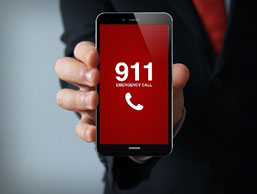
Unless you are the parent of small children, it may come as a surprise that choking is the fourth leading cause of accidental deaths in the United States. The reality is that choking can happen anywhere and to anyone—at school, at work, or in public places.
Choking is the stoppage of the flow of air into the lungs, preventing breathing and inhibiting blood flow to the brain. It can occur partially or complete and prolonged. Lasting injuries or death from suffocation can result. However, with proper preparation, you can help prevent yourself or someone else from choking. Below are some helpful guidelines that help prevent or reduce risk during a choking incident.
Watch for Signs of Choking
- Hands clutching the throat: The most universal and obvious sign of choking, an individual wrapping his or her hands tightly around the throat signifies that breathing is obstructed by an object lodged in the air passageway.
- Wheezing or difficulty breathing/talking: If the individual is wheezing or has difficulty talking or coughing, his or her windpipe may be partially blocked.
- Inability to talk or cough: This suggests the windpipe may be completely blocked, and the individual is in critical danger.
- Change of color in the hands or face: A change in color to an individual’s skin suggests a cutoff of blood circulation. At this stage, brain damage becomes possible; the individual needs urgent help.
- Loss of consciousness: This is the most drastic stage of choking, when brain damage is most probable. Immediate action is necessary to prevent death.
 Give Immediate Care
Give Immediate Care
- Ask someone to call 911 immediately. If you are alone, administer first aid as described below for two minutes before pausing to call 911. Experienced medical professionals can help the individual if you are unable to successfully administer first aid.
- Forcefully deliver multiple back pats in between the individual’s shoulder blades, using the heel of your hand. This motion is especially effective when the object is only causing a partial blockage.
- Should back blows fail to dislodge the object, wrap your hands firmly around the individual’s waist and lock your hands into a fist. If knowledgeable, begin the Heimlich maneuver or abdominal thrusts by shoving your hands upward into the abdominal area.
- If the Heimlich maneuver fails and the individual loses consciousness, perform CPR with chest compressions until medical help arrives.
Take Action While Choking Alone
- Form a tight fist with both hands and forcefully thrust your fist into your upper abdomen. Repeat this until the object is dislodged.
- If this fails, get onto your hands and knees, jam your fist into your upper abdomen and fall onto your stomach. This may create more pressure, setting the object free.
 Give Special Attention to Children and Babies
Give Special Attention to Children and Babies
- Sit down and turn the baby over as soon as you notice he or she is unable to cry or cough. Holding the child over your knees, making sure the head is lower than the body, keep his mouth open with your fingers while you use the other hand to firmly deliver back blows as described above.
- Do chest thrusts if the back blows fail to dislodge the blockage. Turn the child over onto your forearm and, still keeping his head lower than his body, push firmly into the chest using the pads of your fingers.
- Children, especially infants, are most susceptible to choking and require constant monitoring while eating. Cut their food into smaller pieces and avoid feeding them hard candies to keep their smaller windpipes clear.
- Keep small toys and other objects away from babies and toddlers.
What else can you do? If you are not already, get certified in CPR and First Aid. This simple, one-time precaution will equip you to handle choking situations correctly and confidently.
Through leadership, education and vigilance, Allied Universal® is there for you.























